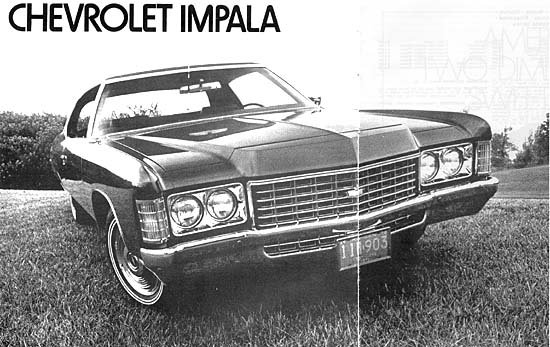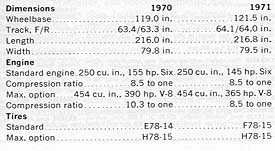

| The good Mr. Agnew's forgotten Americans have not been forgotten by Chevrolet, in no small part because a multitude of them are on the payroll there. And this portion of our country's silent and industrious society has shaped itself an entirely new car for 1971 along the lines of what it figures America needs.
It's easy to overlook the Chevrolet because those who buy it, hardhats excepted, are neither vocal nor seekers of the limelight. And it's even easier to overlook this year because chevrolet has been directing our attention, with many of its advertising dollars, toward one of its peripheral projects-the Vega. But don't be misled. Compared to the Impala, the Vega is kind of a sparetime project which will net the company three or four hundred thousand annual sales with a veneer-thin profit margin on each one. The Impala is the one that counts -- depending upon the economy, to the tune of a million cars per year, plus or minus the equivalent of American Motors' annual output. It is Detroit's leading car, without a doubt. And when its format is altered noticeably it is only as the end result of a thought process that might not be obvious and therefore, deserves attention. That is why in the year 1971-- when all of the automobile world is touting the Vega as the leader of an inexorable small-car trend-the news of the bigger Impala strikes a sobering blow. This size increase is even more significant when you understand that Chevrolet does not indiscriminately adjust the dimensions of its bread-winner. For 1971, the Impala's wheelbase has been increased to 121.5 inches after a 12-year period at 119 inches. Overall length, on the other hand, has grown on a more or less yearly basis and the 0.8-inch increment this year is typical of the annual rate for the last five years. But this silent expansion accumulates to an astounding total size. The latest Impala is now a full foot-and-one-half longer and six inches wider than its counterpart of 15 years ago on a wheelbase that is greater by 6.5 inches. In fact, a Cadillac of that vintage was actually shorter than today's Impala by two full inches. Obviously, this growth business can't go on or we'll be driving Fruehauf-size sedans by the turn of the century. Under close scrutiny, the Impala seems to have grown less by plan than by lack of restraint, like the pot belly that comes with age. And its cautious, evolutionary styling further suggests a car that continues with very little attention to purpose or concept. Yet this car, which seems never to change significantly, is altogether different than the Impala of a year ago -- at a fantastic expense in both engineering and tooling. Altogether different -- new body and new chassis -- to do the same job in the same way. The engineers can defend their work. They will haul forth recorder tapes to show that the new Impala rides perceptibly better to an electronic sensor, has a lower interior noise level and perhaps a marginal improvement in handling. But, blindfolded, not one man in ten could tell the difference. Another round of improvement with no progress. For the really bothersome situations, like parking and edging through urban congestion, there has been not even an attempt at relief. Interior dimensions have been juggled; rear leg room is up significantly but hip room is down and the yawning increase in shoulder space doesn't mean a damn thing since the old model had plenty. All of this should not be construed as a condemnation of Chevrolet's largest seller. It does its job, as seen by General Motors and by the industry, with unprecedented competence and it is typical of its Ford and Chrysler competition. At the same time, the all-new Impala puts the Detroit small car flourish into perspective -- more like a ripple than a wave. |
